Abstract
CMV carrier status of healthy individuals causes a persistent increase in the numbers of lymphocytes expressing the HNK1 (Leu 7) antigen. We investigated this phenomenon by correlating HNK1 fluorescence intensity of the CD3+, CD4+, CD8+ and CD16+ lymphocytes with their morphology. The study was performed on 112 healthy individuals as a function of their CMV carrier status. To this end, the CD3+, CD4+, CD8+ and CD16+ lymphocytes were stratified into subsets with undetectable (-), weak (+) and strong (++) levels of HNK1 fluorescence intensity, as well as into subsets with low, intermediate or high perpendicular light scatter (PLS) signals. Among the CD3+, CD4+ and CD8+ lymphocytes. CMV carrier status was associated with significantly increased numbers of HNK1(+) and particularly HNK1(++) cells. Among the CD16+ lymphocytes, CMV carrier status increased only the HNK1(++) ones significantly. There were clear positive correlations between the PLS characteristics of the CD3+, CD4+, CD8+ and CD16+ lymphocytes and their HNK1 fluorescence intensity. Microscopic analysis of CD3+ lymphocytes sorted into HNK1(-), HNK1(+) and HNK1(++) fractions revealed that the percentage of those cells containing azurophilic granules and the numbers of such granules per cell increased in proportion to their HNK1 fluorescence intensity. Thus, CMV also interacts with the HNK1+ lymphocytes of its healthy carriers by increasing the level of expression of that antigen which is accompanied by increased granularity. Those granular lymphocytes may include cytotoxic cells which are involved in the control of viral replication.
Full text
PDF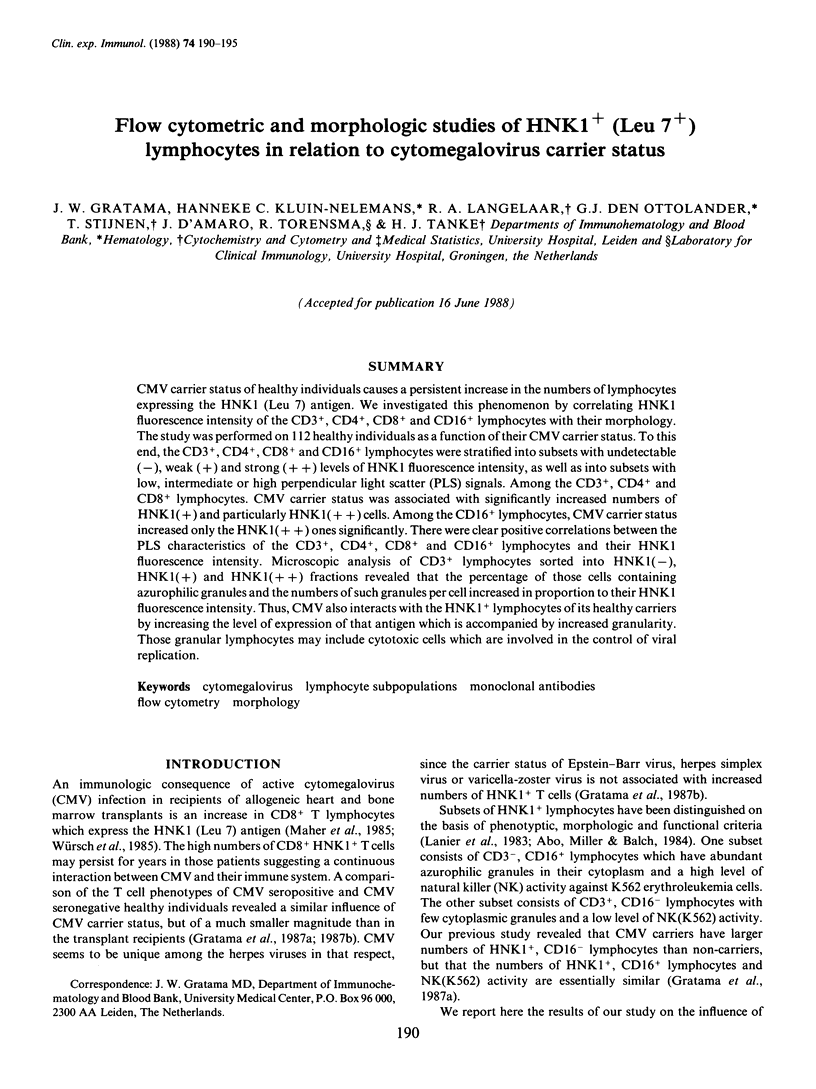
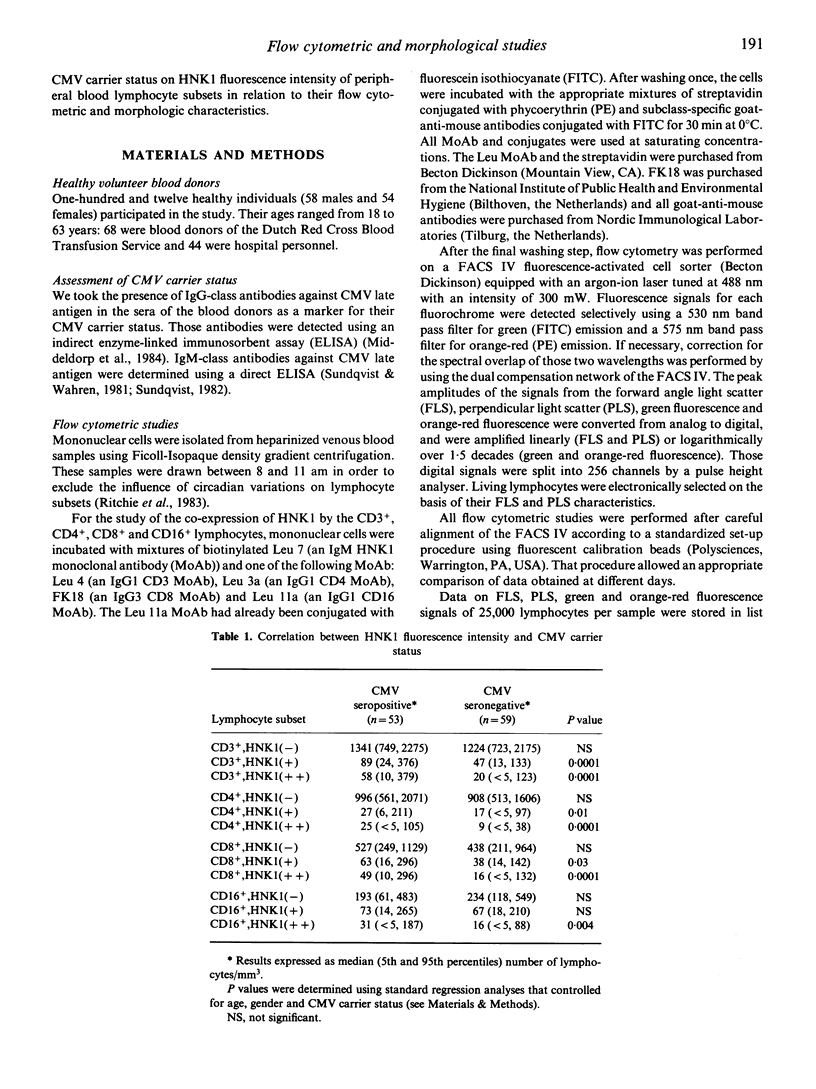
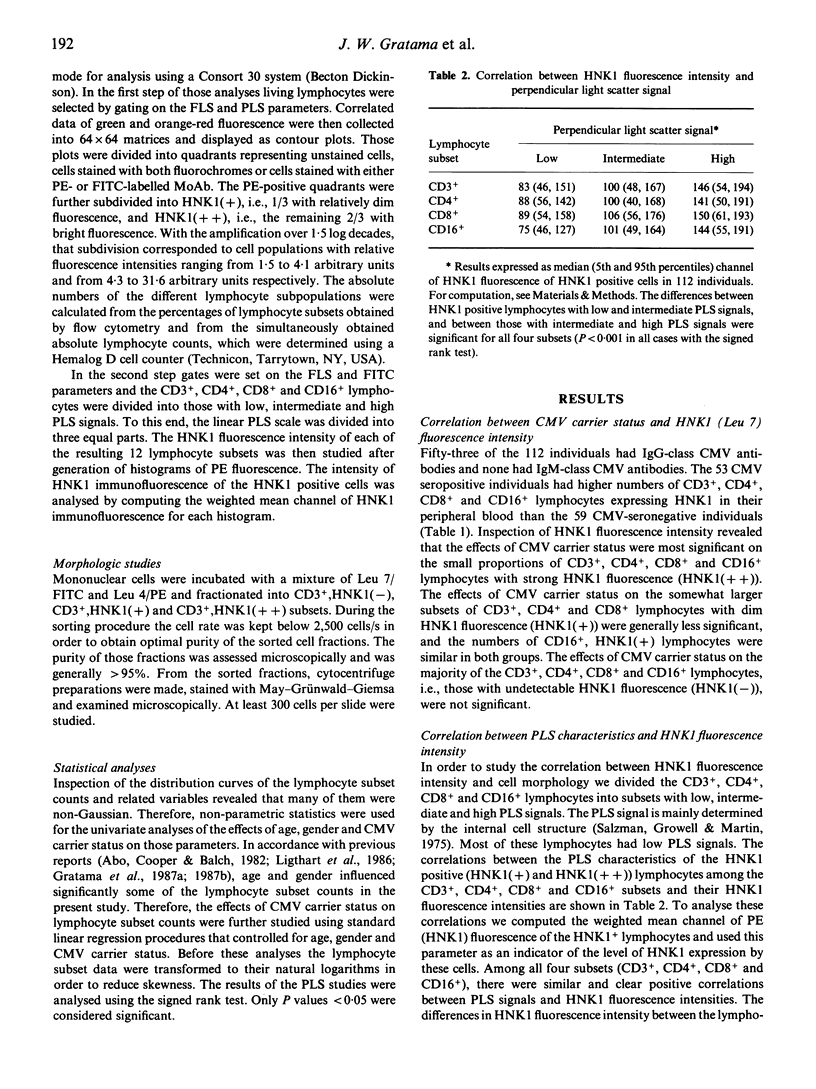
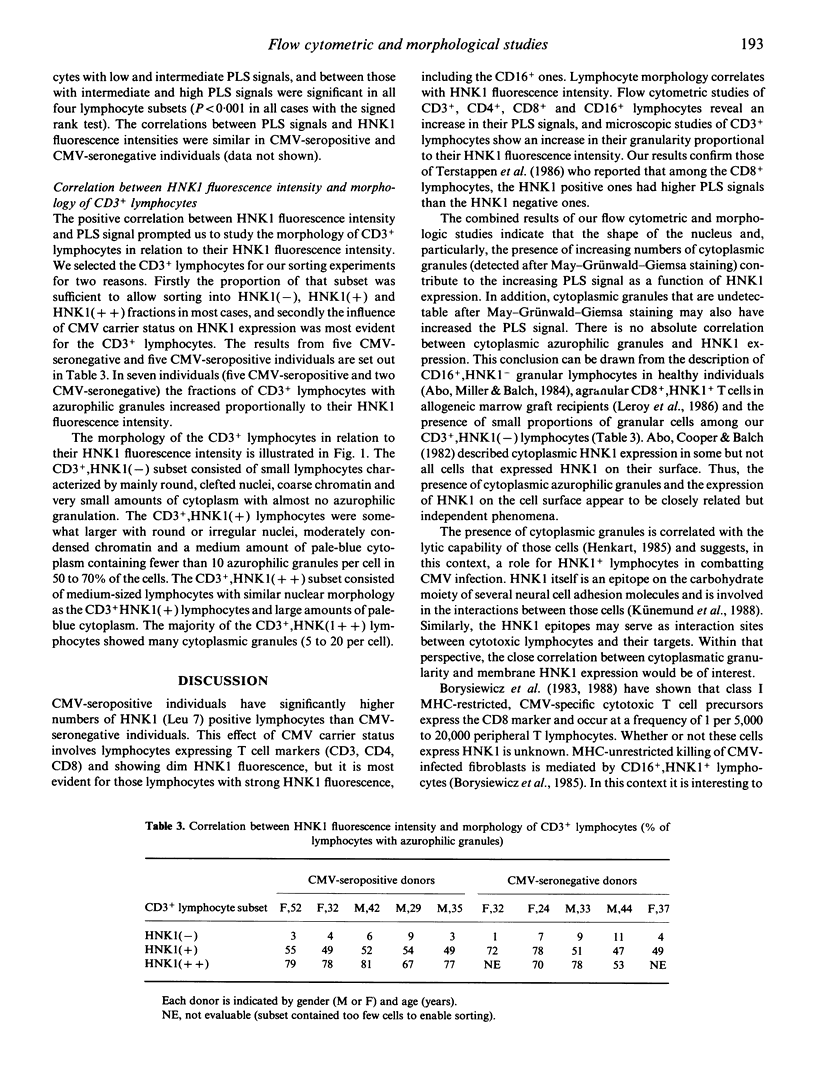
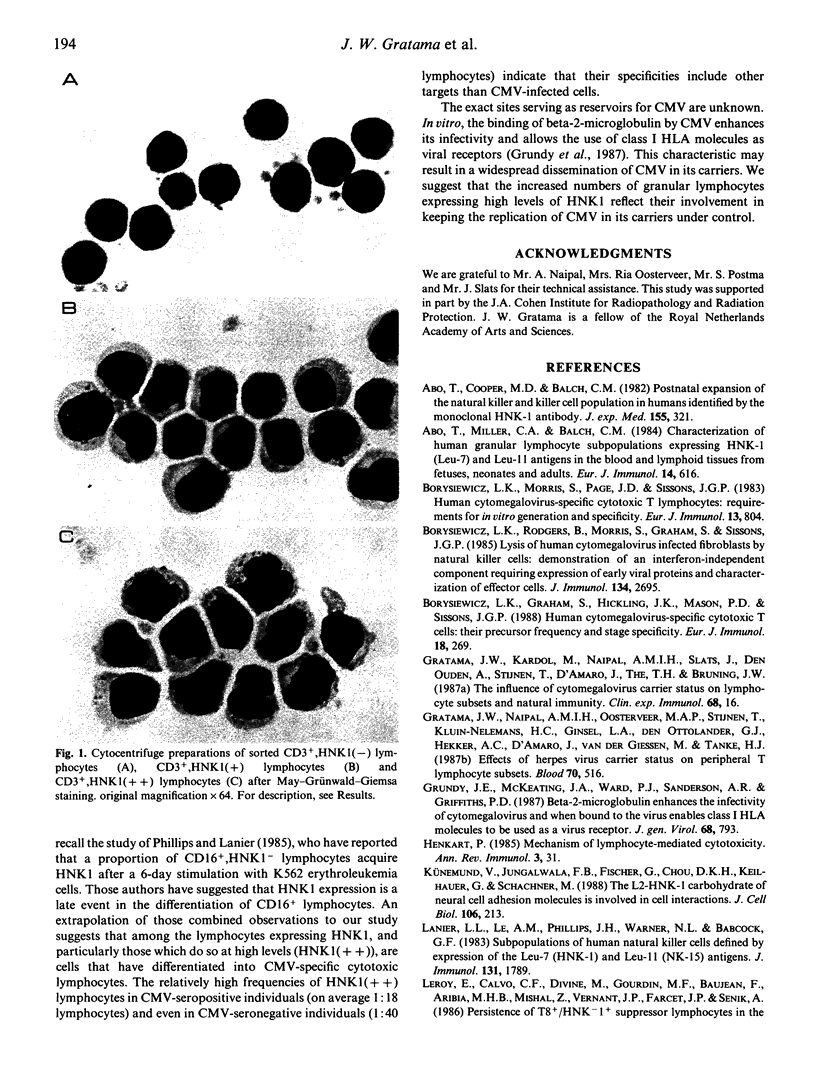
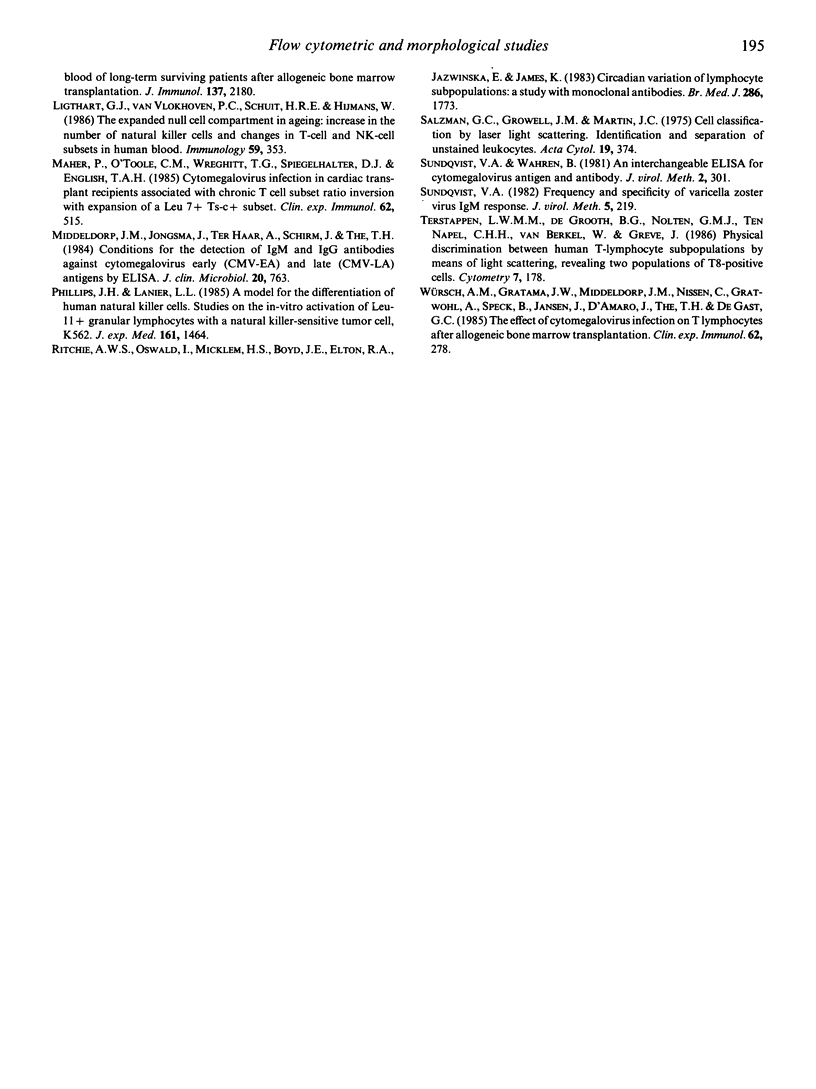
Images in this article
Selected References
These references are in PubMed. This may not be the complete list of references from this article.
- Abo T., Cooper M. D., Balch C. M. Postnatal expansion of the natural killer and keller cell population in humans identified by the monoclonal HNK-1 antibody. J Exp Med. 1982 Jan 1;155(1):321–326. doi: 10.1084/jem.155.1.321. [DOI] [PMC free article] [PubMed] [Google Scholar]
- Abo T., Miller C. A., Balch C. M. Characterization of human granular lymphocyte subpopulations expressing HNK-1 (Leu-7) and Leu-11 antigens in the blood and lymphoid tissues from fetuses, neonates and adults. Eur J Immunol. 1984 Jul;14(7):616–623. doi: 10.1002/eji.1830140707. [DOI] [PubMed] [Google Scholar]
- Borysiewicz L. K., Graham S., Hickling J. K., Mason P. D., Sissons J. G. Human cytomegalovirus-specific cytotoxic T cells: their precursor frequency and stage specificity. Eur J Immunol. 1988 Feb;18(2):269–275. doi: 10.1002/eji.1830180214. [DOI] [PubMed] [Google Scholar]
- Borysiewicz L. K., Morris S., Page J. D., Sissons J. G. Human cytomegalovirus-specific cytotoxic T lymphocytes: requirements for in vitro generation and specificity. Eur J Immunol. 1983 Oct;13(10):804–809. doi: 10.1002/eji.1830131005. [DOI] [PubMed] [Google Scholar]
- Borysiewicz L. K., Rodgers B., Morris S., Graham S., Sissons J. G. Lysis of human cytomegalovirus infected fibroblasts by natural killer cells: demonstration of an interferon-independent component requiring expression of early viral proteins and characterization of effector cells. J Immunol. 1985 Apr;134(4):2695–2701. [PubMed] [Google Scholar]
- Gratama J. W., Naipal A. M., Oosterveer M. A., Stijnen T., Kluin-Nelemans H. C., Ginsel L. A., den Ottolander G. J., Hekker A. C., D'Amaro J., van der Giessen M. Effects of herpes virus carrier status on peripheral T lymphocyte subsets. Blood. 1987 Aug;70(2):516–523. [PubMed] [Google Scholar]
- Grundy J. E., McKeating J. A., Ward P. J., Sanderson A. R., Griffiths P. D. Beta 2 microglobulin enhances the infectivity of cytomegalovirus and when bound to the virus enables class I HLA molecules to be used as a virus receptor. J Gen Virol. 1987 Mar;68(Pt 3):793–803. doi: 10.1099/0022-1317-68-3-793. [DOI] [PubMed] [Google Scholar]
- Henkart P. A. Mechanism of lymphocyte-mediated cytotoxicity. Annu Rev Immunol. 1985;3:31–58. doi: 10.1146/annurev.iy.03.040185.000335. [DOI] [PubMed] [Google Scholar]
- Künemund V., Jungalwala F. B., Fischer G., Chou D. K., Keilhauer G., Schachner M. The L2/HNK-1 carbohydrate of neural cell adhesion molecules is involved in cell interactions. J Cell Biol. 1988 Jan;106(1):213–223. doi: 10.1083/jcb.106.1.213. [DOI] [PMC free article] [PubMed] [Google Scholar]
- Lanier L. L., Le A. M., Phillips J. H., Warner N. L., Babcock G. F. Subpopulations of human natural killer cells defined by expression of the Leu-7 (HNK-1) and Leu-11 (NK-15) antigens. J Immunol. 1983 Oct;131(4):1789–1796. [PubMed] [Google Scholar]
- Leroy E., Calvo C. F., Divine M., Gourdin M. F., Baujean F., Ben Aribia M. H., Mishal Z., Vernant J. P., Farcet J. P., Senik A. Persistence of T8+/HNK-1+ suppressor lymphocytes in the blood of long-term surviving patients after allogeneic bone marrow transplantation. J Immunol. 1986 Oct 1;137(7):2180–2189. [PubMed] [Google Scholar]
- Ligthart G. J., van Vlokhoven P. C., Schuit H. R., Hijmans W. The expanded null cell compartment in ageing: increase in the number of natural killer cells and changes in T-cell and NK-cell subsets in human blood. Immunology. 1986 Nov;59(3):353–357. [PMC free article] [PubMed] [Google Scholar]
- Maher P., O'Toole C. M., Wreghitt T. G., Spiegelhalter D. J., English T. A. Cytomegalovirus infection in cardiac transplant recipients associated with chronic T cell subset ratio inversion with expansion of a Leu-7+ TS-C+ subset. Clin Exp Immunol. 1985 Dec;62(3):515–524. [PMC free article] [PubMed] [Google Scholar]
- Middeldorp J. M., Jongsma J., ter Haar A., Schirm J., The T. H. Detection of immunoglobulin M and G antibodies against cytomegalovirus early and late antigens by enzyme-linked immunosorbent assay. J Clin Microbiol. 1984 Oct;20(4):763–771. doi: 10.1128/jcm.20.4.763-771.1984. [DOI] [PMC free article] [PubMed] [Google Scholar]
- Phillips J. H., Lanier L. L. A model for the differentiation of human natural killer cells. Studies on the in vitro activation of Leu-11+ granular lymphocytes with a natural killer-sensitive tumor cell, K562. J Exp Med. 1985 Jun 1;161(6):1464–1482. doi: 10.1084/jem.161.6.1464. [DOI] [PMC free article] [PubMed] [Google Scholar]
- Ritchie A. W., Oswald I., Micklem H. S., Boyd J. E., Elton R. A., Jazwinska E., James K. Circadian variation of lymphocyte subpopulations: a study with monoclonal antibodies. Br Med J (Clin Res Ed) 1983 Jun 4;286(6380):1773–1775. doi: 10.1136/bmj.286.6380.1773. [DOI] [PMC free article] [PubMed] [Google Scholar]
- Salzman G. C., Crowell J. M., Martin J. C., Trujillo T. T., Romero A., Mullaney P. F., LaBauve P. M. Cell classification by laser light scattering: identification and separation of unstained leukocytes. Acta Cytol. 1975 Jul-Aug;19(4):374–377. [PubMed] [Google Scholar]
- Sundqvist V. A. Frequency and specificity of varicella zoster virus IgM response. J Virol Methods. 1982 Nov;5(3-4):219–227. doi: 10.1016/0166-0934(82)90012-x. [DOI] [PubMed] [Google Scholar]
- Sundqvist V. A., Wahren B. An interchangeable ELISA for cytomegalovirus antigen and antibody. J Virol Methods. 1981 Apr;2(5):301–312. doi: 10.1016/0166-0934(81)90029-x. [DOI] [PubMed] [Google Scholar]
- Terstappen L. W., de Grooth B. G., Nolten G. M., ten Napel C. H., van Berkel W., Greve J. Physical discrimination between human T-lymphocyte subpopulations by means of light scattering, revealing two populations of T8-positive cells. Cytometry. 1986 Mar;7(2):178–183. doi: 10.1002/cyto.990070209. [DOI] [PubMed] [Google Scholar]
- Würsch A. M., Gratama J. W., Middeldorp J. M., Nissen C., Gratwohl A., Speck B., Jansen J., D'Amaro J., The T. H., De Gast G. C. The effect of cytomegalovirus infection on T lymphocytes after allogeneic bone marrow transplantation. Clin Exp Immunol. 1985 Nov;62(2):278–287. [PMC free article] [PubMed] [Google Scholar]



